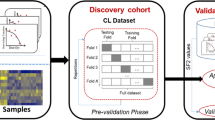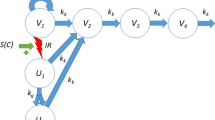Abstract
Radiosensitizers are aimed to augment tumor cell killing by radiation while having much less effect on normal tissues. Nitroimidazoles and related analogues are efficient radiation sensitivity enhancers, and they particularly work on hypoxic tumor cells. In the current study, we have developed two partial least squares (PLS) regression-based two-dimensional quantitative structure-activity relationship (2D-QSAR) models using a novel class of 84 nitroimidazole compounds to understand their radiosensitization effectiveness (pC1.6). Feature selection was done by genetic algorithm along with stepwise regression, while model validation was performed using various stringent validation criteria following the strict rules of OECD guidelines of QSAR validation. The variables included in the models were obtained from Dragon (version 7.0) and simplex representation of molecular structures (SiRMS) (version 4.1.2.270) software. The developed models were robust, externally predictive, and useful tools to predict the radiosensitization effectiveness of nitroimidazole compounds. True external prediction was carried out using a group of six nitroimidazole derivatives and the model reliability was checked using the Prediction Reliability Indicator tool (http://dtclab.webs.com/software-tools). Furthermore, the developed models will give an insight for development of new radiosensitizers with enhanced radiation sensitivity.










Similar content being viewed by others
References
Kvols LK (2005) Radiation sensitizers: a selective review of molecules targeting DNA and non-DNA targets. J Nucl Med 46:187S
Bonnet M, Hong CR, Gu Y, Anderson RF, Wilson WR, Pruijn FB, Wang J, Hicks KO, Hay MP (2014) Novel nitroimidazolealkylsulfonamides as hypoxic cell radiosensitisers. Bioorg Med Chem 22:2123–2132
Cairns RA, Harris IS, Mak TW (2011) Regulation of cancer cell metabolism. Nat Rev Cancer 11:85
Chang Q, Jurisica I, Do T, Hedley DW (2011) Hypoxia predicts aggressive growth and spontaneous metastasis formation from orthotopically grown primary xenografts of human pancreatic cancer. Cancer Res 71:3110–3120
Rohwer N, Cramer T (2011) Hypoxia-mediated drug resistance: novel insights on the functional interaction of HIFs and cell death pathways. Drug Resist Updat 14:191–201
Wilson WR, Hay MP (2011) Targeting hypoxia in cancer therapy. Nat Rev Cancer 11:393
Astor M, Hall EJ, Martin J, Flynn M, Biaglow J, Parham JC (1982) Radiosensitizing and cytotoxic properties of ortho-substituted 4-and 5-nitroimidazoles: role of NPSH reactivity. Int J Radiat Oncol Biol Phys 8:409–413
Koch CJ, Skov KA (1994) Enhanced radiation-sensitivity by preincubation with nitroimidazoles: effect of glutathione depletion. Int J Radiat Oncol Biol Phys 29:345–349
Roy K (2018) Quantitative structure-activity relationships (QSARs): a few validation methods and software tools developed at the DTC laboratory. J Indian Chem Soc 95:1497–1502
Hansch C, Leo A, Hoekman DH (1995) Exploring QSAR: fundamentals and applications in chemistry and biology. American Chemical Society Washington, DC
Hansch C, Leo A, Mekapati SB, Kurup A (2004) Qsar and Adme. Bioorg Med Chem 12:3391–3400
Klein C, Kaiser D, Kopp S, Chiba P, Ecker GF (2002) Similarity based SAR (SIBAR) as tool for early ADME profiling. J Comput Aided Mol Des 16:785–793
Merlot C (2010) Computational toxicology—a tool for early safety evaluation. Drug Discov Today 15:16–22
Xu X, Zhang W, Huang C, Li Y, Yu H, Wang Y, Duan J, Ling Y (2012) A novel chemometric method for the prediction of human oral bioavailability. Int J Mol Sci 13:6964–6982
Yoshida F, Topliss JG (2000) QSAR model for drug human oral bioavailability. J Med Chem 43:2575–2585
Roy H, Nandi S (2019) In silico modeling in drug metabolism and interaction: current strategies of lead discovery. Bentham Science Publishers, Sharjah
Simeon S, Montanari D, Gleeson MP (2019) Investigation of factors affecting the performance of in silico volume distribution QSAR models for human, rat, mouse, dog & monkey. Mol Inform 38:1900059
Halder AK, Cordeiro M (2019) Development of multi-target chemometric models for the inhibition of class I PI3K enzyme isoforms: a case study using QSAR-Co tool. Int J Mol Sci 20:4191
Dmitriev AV, Lagunin AA, Karasev DЦ, Rudik AV, Pogodin PV, Filimonov DA, Poroikov VV (2019) Prediction of drug-drug interactions related to inhibition or induction of drug-metabolizing enzymes. Curr Top Med Chem 19:319–336
Salahinejad M (2015) Quantitative structure property relationships on formation constants of radiometals for radiopharmaceuticals applications. J Radioanal Nucl Chem 303:671–680
Singh S, Ojha H, Tiwari AK, Kumar N, Singh B, Mishra AK (2010) Design, synthesis, and in vitro antiproliferative activity of benzimidazole analogues for radiopharmaceutical efficacy. Cancer Biother Radiopharm 25:245–250
Yoshizuka K, Pietzsch H-J, Seifert S, Stephan H (2013) Quantitative structure property relationship of logP for radiopharmaceutical technetium and rhenium complexes by using molecular dynamics calculations. Solvent Extr Res Dev, Jpn 20:15–27
Santos L, Pilar Cornago M, Izquierdo MC, Consuelo Lopez-Zumel M, Smeyers YG (1989) Electron affinity/radiosensitizing activity relationship for quaternary 5-nitroimidazole derivatives. Quantum chemical QSAR. Quant Struct-Act Rel 8:214–217
Wardman P, Clarke ED (1987) Redox properties and rate constants in free-radical mediated damage. Br J Cancer Suppl 8:172
De P, Bhattacharyya D, Roy K (2019) Application of multilayered strategy for variable selection in QSAR modeling of PET and SPECT imaging agents as diagnostic agents for Alzheimer’s disease. Struct Chem 30:2429–2445
Long W, Liu P (2010) Quantitative structure activity relationship modeling for predicting radiosensitization effectiveness of nitroimidazole compounds. J Radiat Res 51:563–572
MarvinSketch software, https://www.chemaxon.com. Accessed 26 Aug 2019
Dragon version 7, Kodesrl, Milan, Italy, 2016; software available at http://www.talete.mi.it/index.htm. Accessed 26Aug 2019
Kuz’min VE, Artemenko AG, Polischuk PG, Muratov EN, Hromov AI, Liahovskiy AV, Andronati SA, Makan SY (2005) Hierarchic system of QSAR models (1D–4D) on the base of simplex representation of molecular structure. J Mol Model 11:457–467
Golbraikh A, Shen M, Xiao Z, Xiao Y-D, Lee K-H, Tropsha A (2003) Rational selection of training and test sets for the development of validated QSAR models. J Comput Aided Mol Des 17:241–253
Park H-S, Jun C-H (2009) A simple and fast algorithm for K-medoids clustering. Expert Syst Appl 36:3336–3341
Drug Theoretics and Cheminformatics (DTC) laboratory software tools https://dtclab.webs.com/software-tools Accessed 28 Aug 2019
Khan PM, Roy K (2018) Current approaches for choosing feature selection and learning algorithms in quantitative structure–activity relationships (QSAR). Expert Opin Drug Discov 13:1075–1089
Devillers J (1996) Genetic algorithms in molecular modeling. Academic Press, Cornwall, Great Britain
Roy K, Ambure P (2016) The “double cross-validation” software tool for MLR QSAR model development. Chemom Intell Lab Syst 159:108–126
Wold S, Sjöström M, Eriksson L (2001) PLS-regression: a basic tool of chemometrics. Chemom Intell Lab Syst 58:109–130
U. Simca-P, 10.0, info@umetrics.com, www.umetrics.com, Umea, Sweden, 2002. Accessed 30 Aug 2019
Roy K, Mitra I (2011) On various metrics used for validation of predictive QSAR models with applications in virtual screening and focused library design. Comb Chem High Throughput Screen 14:450–474
Ojha PK, Mitra I, Das RN, Roy K (2011) Further exploring rm2 metrics for validation of QSPR models. Chemom Intell Lab Syst 107:194–205
Roy K, Das RN, Ambure P, Aher RB (2016) Be aware of error measures. Further studies on validation of predictive QSAR models. Chemom Intell Lab Syst 152:18–33
Akarachantachote N, Chadcham S, Saithanu K (2014) Cutoff threshold of variable importance in projection for variable selection. Int J Pure Appl Math 94:307–322
Gadaleta D, Mangiatordi GF, Catto M, Carotti A, Nicolotti O (2016) Applicability domain for QSAR models: where theory meets reality. IJQSPR 1:45–63
Rücker C, Rücker G, Meringer M (2007) Y-randomization and its variants in QSPR/QSAR. J Chem Inf Model 47:2345–2357
Krause W, Jordan A, Scholz R, Jimenez J-LM (2005) Iodinated nitroimidazoles as radiosensitizers. Anticancer Res 25:2145–2151
Brown JM, Ning YY, Brown DM, Lee WW (1981) SR-2508: a 2-nitroimidazole amide which should be superior to misonidazole as a radiosensitizer for clinical use. Int J Radiat Oncol Biol Phys 7:695–703
Roy K, Ambure P, Kar S (2018) How precise are our quantitative structure–activity relationship derived predictions for new query chemicals? ACS Omega 3:11392–11406
Friedman JH, Stuetzle W (1981) Projection pursuit regression. J Am Stat Assoc 76:817–823
Du Y, Liang Y, Yun D (2002) Data mining for seeking an accurate quantitative relationship between molecular structure and GC retention indices of alkenes by projection pursuit. J Chem Inf Comput Sci 42:1283–1292
Liu H, Yao X, Liu M, Hu Z, Fan B (2007) Prediction of gas-phase reduced ion mobility constants (K0) based on the multiple linear regression and projection pursuit regression. Talanta 71:258–263
Funding
PD thanks Indian Council of Medical Research, New Delhi, for awarding with a Senior Research Fellowship. KR thanks BRNS, Department of Atomic Energy, Govt. of India, for a Major Research Project (36(3)/14/08/2017-BRNS).
Author information
Authors and Affiliations
Corresponding author
Ethics declarations
Conflict of interest
The authors declare that they have no conflict of interest.
Additional information
Publisher’s note
Springer Nature remains neutral with regard to jurisdictional claims in published maps and institutional affiliations.
Rights and permissions
About this article
Cite this article
De, P., Bhattacharyya, D. & Roy, K. Exploration of nitroimidazoles as radiosensitizers: application of multilayered feature selection approach in QSAR modeling. Struct Chem 31, 1043–1055 (2020). https://doi.org/10.1007/s11224-019-01481-z
Received:
Accepted:
Published:
Issue Date:
DOI: https://doi.org/10.1007/s11224-019-01481-z




